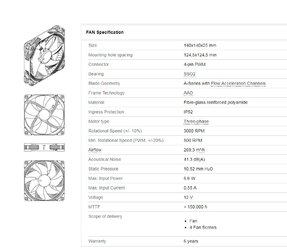They will not work as a heatsink.
That isn't very high static pressure. Here is an ek varder, for example:
https://www.ekwb.com/shop/ek-vardar-f3-120-1850rpm
Sell those and grab the varders if you want static pressure and less noise.

Thanks for responding

I thought the SanyoDenki's might add to the cooling capacity due to them having a metal frame, but after reading these responses I guess I'm just not going to be using them anyway, so yeah, I'll probably put them on eBay.
30 FPI rads were the norm back 10-15 years ago or so. Everyone loves liquid cooling temps and low audibles nowadays. What you're basically building up is the complete opposite of that but if you want to use those screamers, by all means have at it, just don't catch a finger near those spinning blades as I would highly recommend a fan grill.
If you're looking for low audible liquid cooling that most do in this day n age, I would highly recommend 8-16 FPI at the most. The lower the FPI, the lower the fan speed, the quieter the audibles. Of course if you're looking for great delta's, you'll need more heat surface on an efficient flowing loop.
As Earthdog points out, make sure you pay attention to static pressure and not CFM. CFM is usually used for air flow in general. Static pressure is measured to go through things like a radiator. All dependent on blade designs, etc.
Thanks, I'm probably going to be upgrading to a separate pump and reservoir but I'm going to be doing it incrementally because of the cost, and so that I can monitor the performance increase. If I can get my 4790k to its maximum performance using an Eisbaer I'll probably just stick with the Eisbaer, but something tells me my 4790k has a lot more left in the tank, especially with my motherboard and PSU setup. They're super stable and my overclock just seems to be thermally limited.
But yeah, having read this thread I'll just stick those fans on eBay. I bought them years ago when I used to be a bit obsessed with efficient air cooling. They're also so out of date that I can't even find the specs for the particular model number I have. :/
Having said that I have a closed loop on my GTX 970 that I fitted a few years ago and I might try them with that to see what difference they might make.
So is pressure definitely preferable to airflow for 16 fpi rads?
I was thinking of using Aerocool Dead Silence 140mm as they seem to even outperform the 140mm Varders at a much slower speed:
EK-Vardar EVO 140S BB (500-1150rpm)
- Noise Level: 26 dBA (100% PWM)
- Max Air Flow: 64 CFM = 109 m³/h
- Static Pressure: 1.08mm H₂O
Aerocool Dead Silence 140mm (1000rpm)
- Noise Level: 14.2dBA at full speed (3-pin fan / no PWM circuit)
- Max Air Flow: 64.8 CFM = 109.8 m³/h
- Static Pressure: 1.21 mm H₂O
Noctua NF-A14 industrialppc-2000 PWM (500-2000rpm)
- Noise Level: 31.5dBA (100% PWM)
- Max Air Flow: 107.4 CFM
- Static Pressure: 4.18 mm H₂O
I know it probably doesn't scale linearly but a rule of thumb I use to get a general figure for efficiency, is to divide either CFM or Static pressure by dBA.
Which of these three fans do you guys think would be better for a 16 fpi rad?
EK-Vardar EVO 140S BB (500-1150rpm)
dBA at 100% speed: 26
2.4615 CFM per dBA
0.0415 mm H₂O per dBA
Aerocool Dead Silence 140mm (1000rpm)
dBA at 100% speed: 14.2
4.563 CFM per dBA
0.0852 mm H₂O per dBA
Noctua NF-A14 industrialppc-2000 PWM (500-2000rpm)
dBA at 100% speed: 31.5
3.45893 CFM per dBA
0.13462 mm H₂O per dBA
At 16 fpi is it really necessary to favour static pressure, if it means extra noise?
The product page on the Hardware Labs site for the Nemesis GTS 280 X-Flow rad states that it's "
...optimized for sub-800 rpm ultra-stealth fans"
I'm tempted to go with the 140mm Aerocool Dead Silence fans.
EDIT: Although there are reports that Aerocool Dead Silence fans can't be mounted horizontally without creating much more noise and that mounting them horizontally can cause the bearings to fail. I'm not sure as to the veracity of that information but that is out there.

